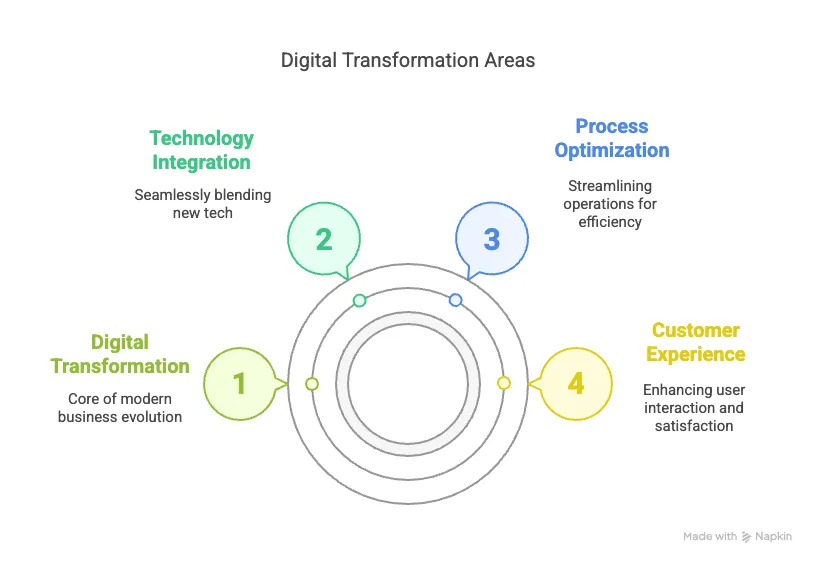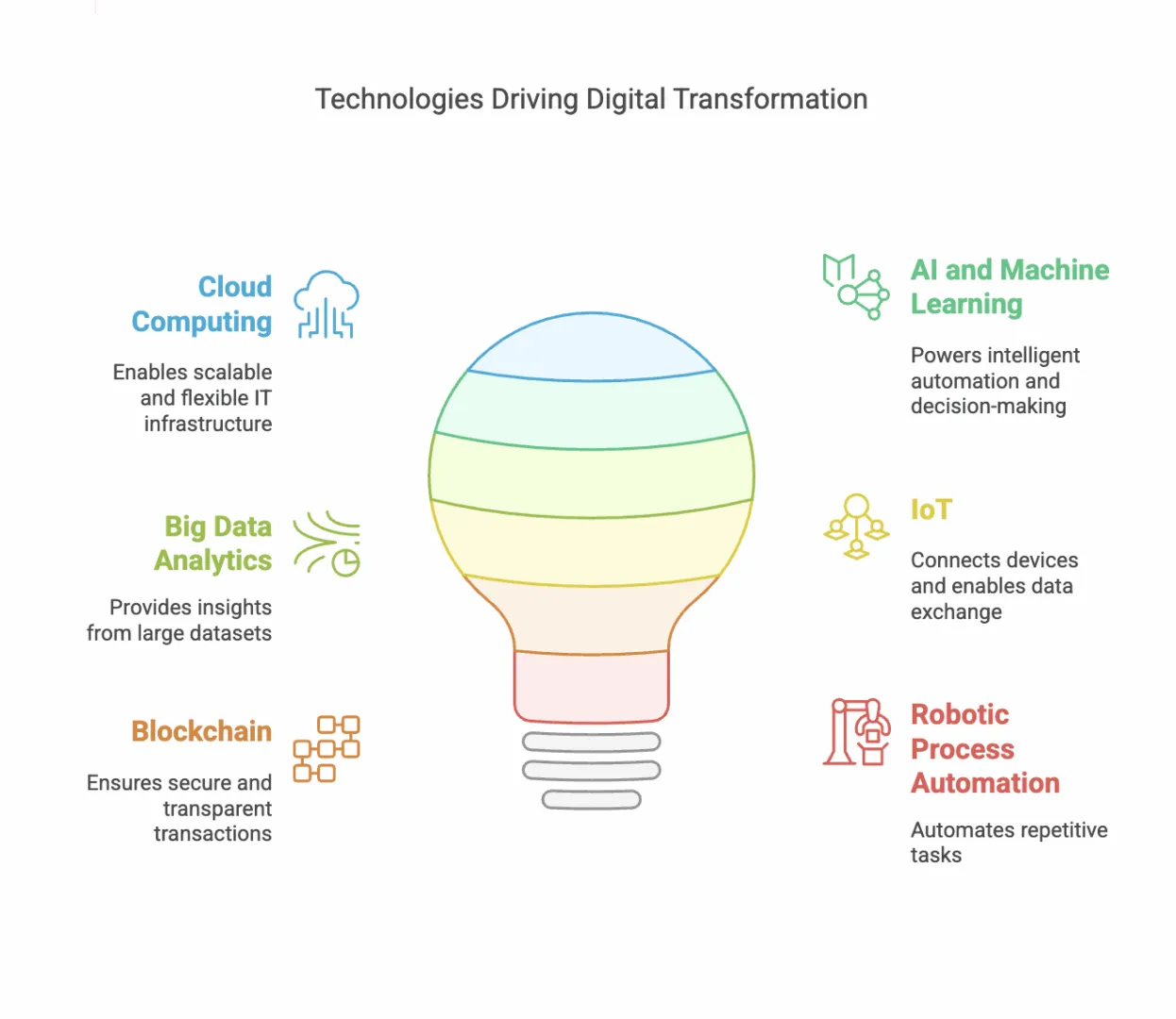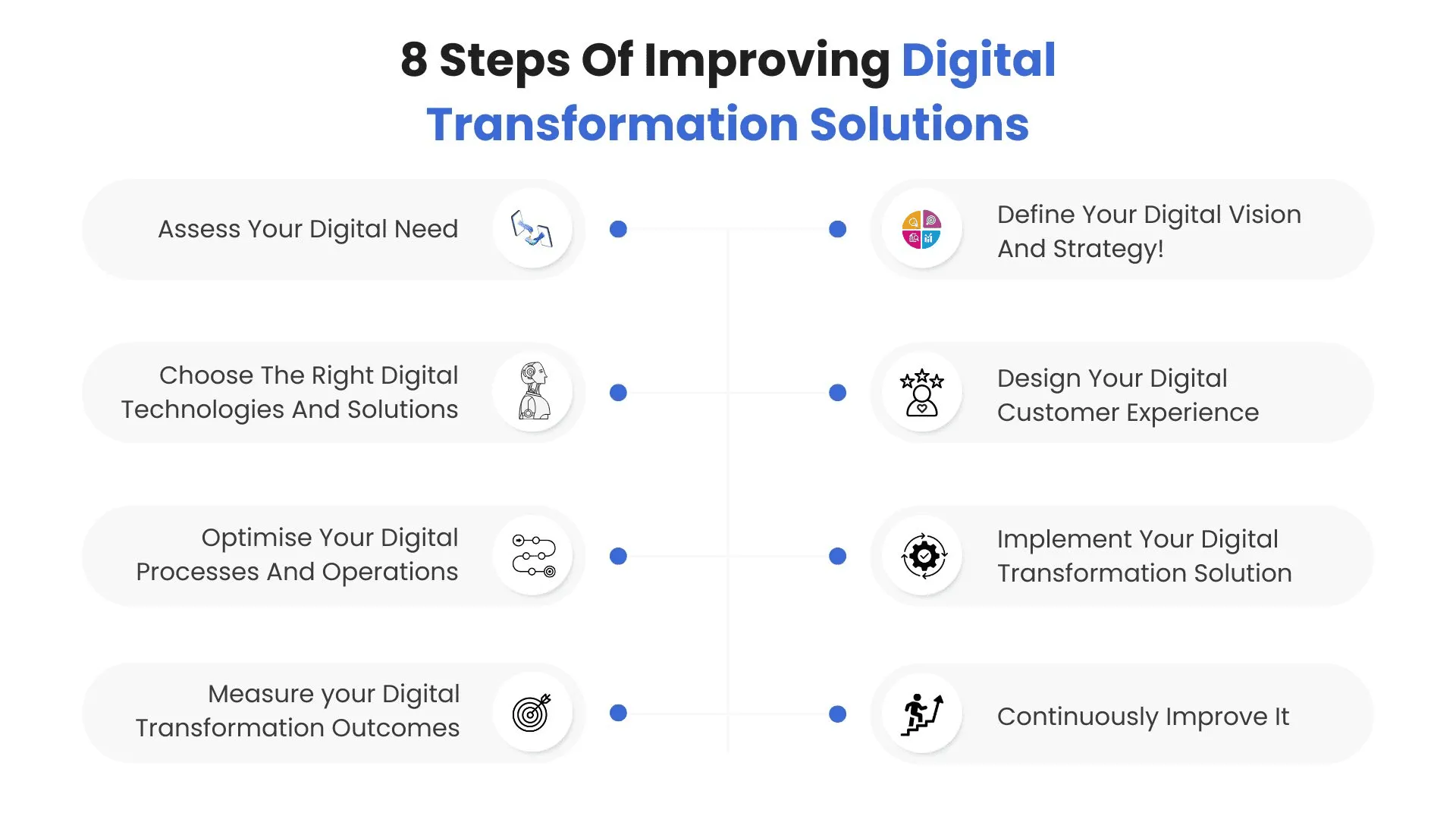Table of Contents
The times have changed and the world is rapidly getting digitalised.
You’re reading this blog because you know the way you’re running the business now is not going to cut it for the upcoming future.
Your costs are rising due to manual procedures, processes seem broken and customers want more personalised experience.
That’s why without a clear roadmap for digital transformation solutions it all seems weak.
So, here we will understand how you can utilise digital transformation solutions properly and scale your business
Let’s dive deep into it.
What Are Digital Transformation Solutions And Why Are They Important?
Let’s know about what digital transformation solutions are and how they are important for businesses.
Digital transformation solution is a structured way of running a business using strong processes and using emerging technologies.
These solutions are designed to help businesses to adapt faster in this technological environment and excel at their growth.
But, how are they so important?
1. Enhance Competitiveness – Now businesses can deliver more personalised services using new technologies.
2. Increase Efficiency – When you know how to use new technologies and systems efficiently then it gives you the ability to enhance your efficiency.
3. Make Data Driven Decisions – With the integration of analytics and Business intelligence tools you can study users deeply and make better decisions based on that.
4. Build Robust System & Trust – When you can make your systems and processes completely secured with cybersecurity and better customer experience, the trust factor increases.
In fact, the global spending on digital transformation is going to be $3.5 Trillion by 2026. Think about it, how big is this going to be?
What are the 4 main areas of digital transformation?
Digital Transformation can be broken down into 4 segments and these are the basic digital solution you need.

1. Business Process Transformation
It basically involves in optimising the internal workflow nd operations using digital tools and updated technologies.
It includes automating repetitive tasks, bringing AI for decision making and adopting ERP or CRM systems to improve efficiency.
2. Customer Experience Enhancement
If you’re running a business you need to look into improving customer experience. It is all about improving what they feel by connecting with your business.
Now, with proper data analytics tool, and responsive customer experience you can improve this in your organisation.
Thats’ why digital transformation is really important.
3. Transforming Your Workforce
With changing times your workforce need to upgraded with new tech.
That’s why your employees need to get equipped with modern digital tools, remote collaboration platforms and continuous learning opportunity in tech.
They need to adapt the digital first mindset which will also improve their productivity and overall growth.
4. Business Model Transformation
Through digital revolutions your company can deliver better & faster value that will impact revenue positively.
You can easily shift from product based model to subscription based model and too by meeting your market demands.
Why Are Digital Transformation Solutions Important?
There are multiple benefits that company gets by implementing digital transformation solutions.
Here are the top 5 benefits you can’t ignore:
- Increased Operational Efficiency: With it transformation solutions you can automate routine tasks, integrates new system and optimize workflow smoothly. This helps is reducing manual error and lower operational cost.
- Improved customer Experience: With AI driven chatbots, personlized communication, and omni channel support companies can give quality service that would lead to customer satisfaction and longer customer retention.
- Data Driven Decision Making: With the emergence of pwoerful digital tools it became easy to track data and make better decision using those data across various department.
- Scalability and Agility: With the integration of cloud based platforms and modular solutions businesses can seamlessly adapt. This will help them in scaling the business effectively.
- Innovation & Competitve Edge: With the adoption of new technologies, companies can build a culture of innovation that enables rapid experimentation and the rollout of new offerings. Just as recognition through a wooden plaque symbolizes achievement and growth, digital transformation allows businesses to stay competitive in a fast-changing market.
That’s why digital solutions implementation is getting important rapidly.
6 Technologies Powering Digital Transformation
Here are the list of 6 technologies those are changing Digital Transformation Solution completely.

1. Cloud Computing
Cloud computing provides on demand access to computing resources like servers, storage, and applications over the internet.
With cloud computing you can avoid costly infrastructure and enable business to scale operations efficiently.
2. Artificial Intelligence And Machine Learning
Businesses have vast amount of data that gets misplaced most of the time.
That’s where AI & ML steps in that manages and study the data efficiently. Businesses benefits by learning the patterns from the data.
This improves marketing strategy, better decision making and overall growth.
3. Big Data Analytics
With Big Data you’ll be able to process and analyze large sets of structured and unstructured data easily. From that you can get actionable insights.
You understand your customers well, optimize the operations and many more.
4. Internet Of Things (IoT)
IoT refers to interconnected physical devices (like sensors, machines, or any wearables) that collect and transit data in real time.
IoT is used widely in industries like manufacturing, healthcare, and logistics to track their performance, lower the downtime.
5. Blockchain
Why blockchain is really useful? Because blockchain is completely decentralized that ensures transparency and security in transactions.
It is usually in supply chain tracking, making digital contract, and secure digital identity management.
6. Robotic Process Automation
RPA uses software bots to automate repetitive, rule based tracks such as data entry, invoice processing and many more.
You’ll save time and you’ll scale fast. You can achieve this level of growth by implementing these tech with proper Digital Transformation Services. Lets’ dive deep into.
8 steps of Digital Transformation Solutions

These 8 steps will help you get the proper solutions for digital transformation.
Step 1: Assess Your Digital Need

The first step to mastering digital transformation solutions is to assess your current state and future goals. You need to understand where you are, where you want to go, and what gaps you need to fill.
To do this, you can use a framework or a checklist that can help you evaluate your digital maturity and readiness. Then, you’ll be able to figure out where to implement the solutions for digital transformation.
Here are some important aspect you need to assess:
- Your business objectives and priorities
- Your customer needs and expectations
- Your competitive landscape and market trends
- Your current digital capabilities and assets
- Your organizational culture and mindset
- Your skills and talent gaps
- Your budget and resources
By conducting a thorough assessment, you can identify your strengths, weaknesses, opportunities, and threats. You can also benchmark yourself against your competitors and industry best practices.
This will help you set realistic and measurable goals for digital solutions implementation.
Step 2: Define your digital vision and strategy

The next step to master digital transformation solutions is to define your digital vision and strategy.
You need to have a clear and compelling vision of what you want to achieve with it transformation solutions and how you will get there.
To do this, you can use a framework or a template that can help you craft your digital vision and strategy.
Some of the elements that you need to define are:
- Your value proposition: What value do you offer to your customers with digital transformation?
- Your target segments: Who are your customers and what are their needs, preferences, and behaviors?
- Your value chain: How do you deliver value to your customers with digital processes, products, services, and experiences?
- Your revenue streams: How do you generate income from your digital offerings?
- Your cost structure: What are the main costs involved in creating and delivering your digital offerings?
- Your key resources: What are the main assets and capabilities that enable your digital offerings?
- Your key partners: Who are the main stakeholders and collaborators that support your digital offerings?
- Your key activities: What are the main tasks and processes that you need to perform to create and deliver your digital offerings?
By defining your digital vision and strategy, you can align your business objectives with your customer needs. You can also communicate your vision and strategy to your employees, partners, investors, and customers.
This will help you gain their buy-in and support for your digital transformation journey.
Step 3: Choose the right digital technologies and solutions

The third step to mastering digital transformation solutions is to choose the right digital technologies and solutions that align with your vision and strategy.
You need to select the appropriate tools and platforms that can help you create and deliver value to your customers.
To do this, you can use a list or a matrix that can help you compare and evaluate the most common and relevant digital technologies and solutions for different industries and domains.
Some of the categories and examples of digital technologies and solutions are:
- Cloud computing: The delivery of computing services such as servers, storage, databases, networking, software, analytics, and intelligence over the internet.
Examples: Amazon Web Services, Microsoft Azure, Google Cloud Platform. - Artificial intelligence: The simulation of human intelligence processes by machines such as learning, reasoning, and self-correction.
Examples: IBM Watson, Google DeepMind, and Microsoft Cortana. - Internet of Things: The network of physical objects that are embedded with sensors, software, and other technologies that enable them to connect and exchange data with other devices and systems.
Examples: Nest, Fitbit, Philips Hue. - Blockchain: The system of recording and verifying transactions using a distributed ledger that is shared and synchronized among multiple parties.
Examples: Bitcoin, Ethereum, Hyperledger. - Augmented reality: The technology that overlays digital information or images on the physical world.
Examples: Pokemon Go, Snapchat, and Microsoft HoloLens. - Virtual reality: The technology that creates a simulated environment that immerses the user in a realistic or imaginary world.
Examples: Oculus Rift, HTC Vive, and Sony PlayStation VR.
By choosing the right digital technologies and solutions, you can leverage the latest innovations and trends that can enhance your competitive advantage and customer satisfaction.
You can also optimize your cost and performance by using the best-fit solutions for your business needs.
Step 4: Design your digital customer experience

The fourth step to mastering digital transformation solutions is to design your digital customer experience.
You need to Create a website based on your business goals and website audit customer-centric and seamless digital experience that meets or exceeds your customer expectations.
To do this, you can use a framework or a tool that can help you map out your customer journey and touchpoints.
Some of the steps and questions that you need to consider are:
- Define your customer persona: Who is your ideal customer and what are their demographics, psychographics, goals, and pain points?
- Identify your customer touchpoints: What are the points of interaction between your customer and your business across different channels and stages?
- Evaluate your current customer experience: How do your customers feel and behave at each touchpoint? What are their needs, emotions, and actions?
- Identify the gaps and opportunities: Where are the pain points and friction points in your current customer experience? How can you improve or eliminate them?
- Design your desired customer experience: How do you want your customers to feel and behave at each touchpoint? What are the solutions or enhancements that you can offer?
By designing your digital customer experience, you can create a consistent and personalized experience that delights your customers and builds loyalty.
You can also increase your customer retention and referrals by exceeding their expectations.
Step 5: Optimize your digital processes and operations.

The fifth step to mastering digital transformation solutions is to optimize your digital processes and operations. You need to streamline and automate your digital processes and operations that support your digital offerings and customer experience.
To do this, you can use a framework or a tool that can help you identify and eliminate inefficiencies and redundancies in your digital processes and operations.
Some of the benefits and examples of optimizing your digital processes and operations are:
- Reduce costs and errors by eliminating manual tasks and human errors
- Increase speed and quality by automating repetitive tasks and workflows
- Enhance flexibility and scalability by adapting to changing demands and volumes
- Improve visibility and control by monitoring and measuring performance and outcomes
- Enable innovation and collaboration by integrating data and systems across functions and departments
By optimizing your digital processes and operations, you can improve your efficiency, productivity, quality, and agility.
By having accurate digital solutions you can free up time and resources for more value-added activities such as innovation and customer service.
Step 6: Implement your digital transformation solution

The sixth step to mastering a digital transformation solution is to implement your digital transformation solution. You need to execute your digital transformation solution with agility and quality.
To do this, you can use a framework or a tool that can help you plan, manage, and monitor your digital transformation project. For example, you can use the Agile Methodology by Atlassian.
Some of the best practices and examples of implementing successful digital transformation solutions are:
- Define clear roles and responsibilities for each team member
- Break down large goals into smaller tasks
- Deliver value and feedback to your customers and stakeholders by delivering working solutions and prototypes
- Embrace change and uncertainty by adopting an iterative and incremental approach
- Learn and improve by conducting regular reviews and retrospectives
By implementing your digital transformation solution, you can turn your vision and strategy into reality. You can also validate your assumptions and hypotheses by testing your solutions with real customers and data.
Step 7: Measure your digital transformation outcomes

The seventh step to mastering digital transformation solutions is to measure your digital transformation outcomes. You need to track by having proper goals and KPIs.
To do this, you can use a framework or a tool that can help you define, collect, and analyze your key performance indicators (KPIs).
Some of the categories and examples of digital transformation KPIs are:
- Financial: The impact of digital transformation on your revenue, profit, cost, and return on investment.
Examples: Revenue growth, cost reduction, profit margin, ROI. - Customer: The impact of digital transformation on your customer satisfaction, loyalty, retention, and acquisition.
Examples: Customer satisfaction score, net promoter score, customer lifetime value, customer acquisition cost. - Internal: The impact of digital transformation on your internal efficiency, productivity, quality, and innovation.
Examples: Process cycle time, defect rate, employee engagement, and innovation rate. - Learning and growth: The impact of digital transformation on your skills, capabilities, culture, and mindset.
Examples: Skill gap analysis, capability maturity model, organizational culture assessment, and digital mindset index.
By measuring your digital transformation outcomes, you can assess the effectiveness and value of your digital transformation solution. You can also identify the areas of improvement and optimization for your future actions.
Step 8: Continuously improve your digital transformation solution

The eighth and final step to mastering digital transformation solutions is to continuously improve your digital transformation solution.
You need to adapt and evolve your digital transformation solution in response to changing customer needs, market trends, and technological innovations.
To do this, you can use a framework or a tool that can help you conduct regular feedback, testing, and iteration cycles.
Some of the steps and questions that you need to consider are:
- Build: What are the assumptions and hypotheses that you need to test with your digital transformation solution?
- Measure: How will you collect and analyze data and feedback from your customers and stakeholders.
- Learn: What are the insights and learnings that you can derive from the data and feedback?
- Pivot or persevere: Based on the learnings, will you change or continue with your current digital transformation solution?
By continuously improving your digital transformation solution, you can ensure that your solution remains relevant and valuable for your customers and business.
You can also foster a culture of learning and experimentation that drives innovation and growth.
What Is Digital Procurement Transformation?
In the age of digital world having a shift in procurement is really necessary.
That’s where digital procurement transformation comes in. It’s the shift from manual to digital with automated procurement systems.
With this evolution entire process of sourcing, managing and purchasing changed completely.
Here’re the benefits that it provides
- Improved Supplier Collaboration And Risk Management – It can be done by leveraging real time data, cloud platforms and automation. No more traditional approach as it all can be automated and made faster.
- Having E Procurement Systems – Having centralized procurement activities that reduce errors significantly and improve compliance rate.
- Supports Sustainability And ESG Goals – It really helps organisations meet their sustainability and Environmental, Social, and Governance goals. It helps in tracking carbon foot prints, energy waste, and waste generation.
Conclusion
Digital transformation is not a destination but a journey. It requires a strategic vision, a customer-centric approach, a technology-enabled solution, an agile execution, a data-driven evaluation. And, an organisation that wants to adapt.
By following these 8 easy steps, you can master digital transformation solutions and achieve your business objectives. You can also create a competitive advantage and a loyal customer base in the digital age.
Are you ready to start or continue your digital transformation journey? Then, our comprehensive digital enterprise transformation solutions will help you.
If yes, then contact us today to find out how we can help you with our expert guidance and support.
FAQ
1. What Are Digital Transformation Software?
Digital transformation software is crucial in building technology transformation solutions. This helps companies in getting leverage using digital technologies such as cloud computing, AI, automation and data analytics.
2. What Are The Four Pillars Of Digital Transformation?
These are four important pillars of digital transformation that helps in proper digital solutions implementation.
1. Enhance team culture and talent
2. Improves operational efficiency
3. Bring in modern technology and growth
4. Quicker insights in data and intelligence.
3. What Is The Main Goal Of Digital Transformation?
The main goal of digital transformation is to improve business processes and performance by leveraging digital technologies. This leads in enhanced customer satisfaction, streamlined operations.
With enhances digital solutions implementation you will be able to maximise the growth.
4. What is the difference between ERP and digital transformation?
ERP (Enterprise Resource Planning): A software system that integrates core business processes—like finance, HR, inventory, supply chain, and manufacturing—into a single platform for better efficiency and data flow.
Digital Transformation: A broader business strategy that uses solutions for digital transformation (including ERP) to radically change how a company operates, delivers value, and competes in the market.
5. What Are The Best Digital Transformation Solutions For Global Enterprises?
The best digital transformation solutions for global enterprises include cloud-native platforms and generative AI tools, which 27% of organizations are currently piloting, with cloud platforms providing flexibility and scalability to adapt to shifting market demands and support hybrid work models.
Leading enterprise solutions encompass digital strategy consulting, agile software development, customer experience design, data and analytics platforms, workflow automation tools like ServiceNow, and comprehensive cybersecurity framework.
6. What Are The Latest Technology Solutions For Digital Transformation?
The latest technology solutions include artificial intelligence as a foundational amplifier that accelerates progress across all domains, combining aspects of applied AI and generative AI to revolutionize content creation, enhance customer experiences, and automate complex tasks.
Key technologies driving transformation include hyperautomation combining RPA, AI, ML, and business process management, advanced cloud technologies, low-code/no-code development platforms, AIOps, Customer Data Platforms (CDPs), intelligent search, and platforms integrating Agile, DevOps, and ITSM.